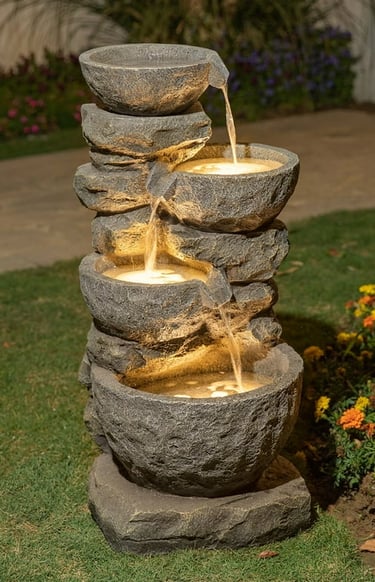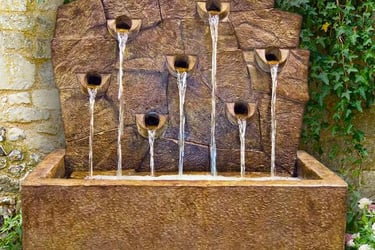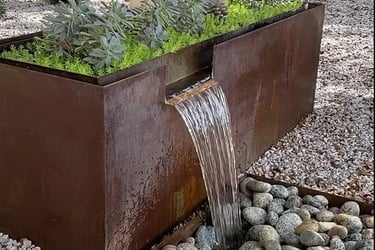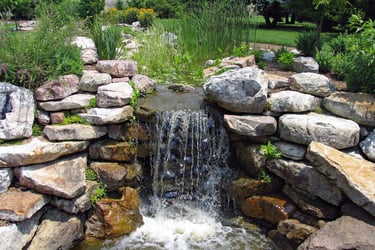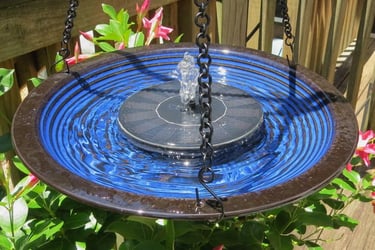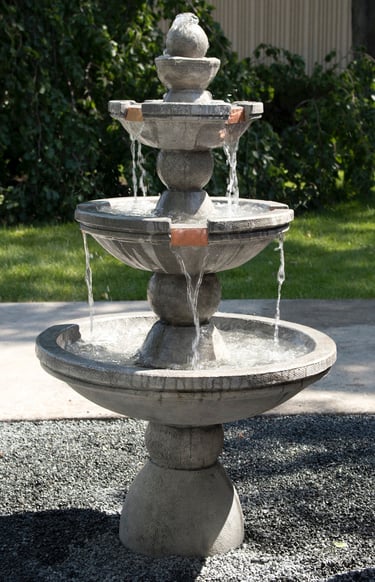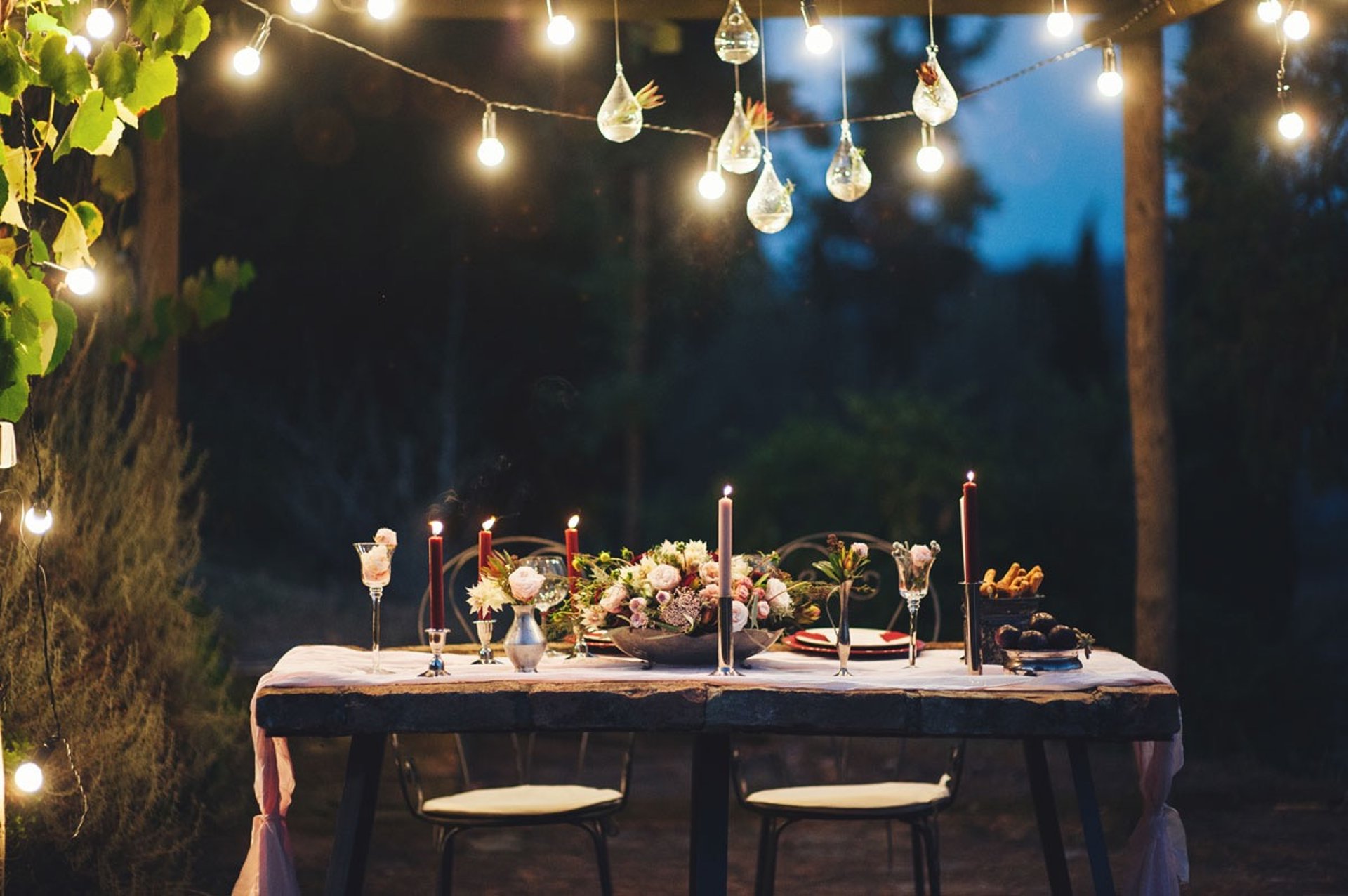
Benefits of Adding a Fountain to Your Garden: Explore the Calming Effects and Aesthetic Appeal of Garden Fountains
Discover how adding a fountain can transform your garden into a serene and elegant retreat. Learn about the calming benefits of flowing water, how to choose the right fountain style for your space, and practical tips for maintaining beauty and tranquility year-round.
WATER FEATURES
P & P
10/8/20254 min read


Benefits of Adding a Fountain to Your Garden: Explore the Calming Effects and Aesthetic Appeal of Garden Fountains
Disclosure: Papaver and Petals is a participant in the Amazon Services LLC Associates Program, an affiliate advertising program designed to provide a means for sites to earn fees by linking to Amazon.com and affiliated sites. As an Amazon Associate, we earn from qualifying purchases at no extra cost to you.
Introduction
There’s something undeniably soothing about the sound of running water. Whether it’s the gentle trickle of a wall fountain or the rhythmic flow of a tiered centerpiece, a garden fountain adds movement, life, and harmony to any outdoor space.
Beyond their visual beauty, fountains have tangible benefits — they calm the mind, attract wildlife, and improve the sensory experience of your garden. With the right design and placement, even a small fountain can transform your backyard or patio into a sanctuary of tranquility and refined style.
1. The Calming Power of Flowing Water
Water has a profound effect on our emotional well-being. The sound of a fountain can:
Reduce stress and anxiety by mimicking natural rhythms found in streams and rainfall.
Promote relaxation and help mask background noise from traffic or neighbors.
Encourage mindfulness, making your garden a place to unwind or meditate.
Studies in environmental psychology show that exposure to moving water can lower blood pressure and improve mood — which makes adding a fountain not just an aesthetic choice, but a wellness investment.
2. Enhancing Your Garden’s Aesthetic Appeal
A well-placed fountain serves as both a visual focal point and a design unifier. The movement of water adds dynamism to static landscapes, catching sunlight and drawing the eye through the space.
Fountain Styles to Consider:
Tiered Fountains – Classic and timeless, perfect for formal gardens or Mediterranean-inspired courtyards.
Wall Fountains – Ideal for smaller patios or courtyards, bringing elegance without taking up space.
Modern Basins – Minimalist and sleek, great for contemporary landscapes.
Natural Rock Fountains – Blend effortlessly into native plantings and rustic gardens.
Solar-Powered Bird Bath Fountains – Lightweight and eco-friendly, combining form and function.
Whatever the style, a fountain introduces movement, texture, and sound — elements that elevate the sensory richness of your outdoor environment.
3. Supporting Wildlife and the Local Ecosystem
A garden fountain isn’t just beautiful — it’s beneficial to the environment. Flowing water attracts birds, butterflies, and beneficial insects seeking hydration or cooling spots.
Birds use shallow basins for bathing and drinking.
Pollinators are drawn to nearby moisture and native blooms.
Frogs and dragonflies may appear in more natural, rock-style installations.
To keep the ecosystem balanced, choose a recirculating pump system (VIVOSUN 800GPH Submersible Pump - https://amzn.to/3LObGXk) and avoid chemical cleaners that could harm wildlife. Adding aquatic or marginal plants nearby enhances both the look and ecological value.
4. Selecting the Right Fountain for Your Space
The key to a successful fountain installation is scale and placement. Consider the following when planning your design:
Proportion: A large, tiered fountain suits expansive gardens, while compact fountains fit patios or entryways.
Material: Stone, ceramic, and cast concrete offer durability and character; lightweight resin works well for smaller spaces.
Sound: A tall drop creates a bold splash; a gentle trickle is softer and more meditative.
Power source: Solar-powered or low-voltage electric options offer flexibility and energy efficiency.
The Sunnydaze 2-Tier Solar Water Fountain (https://amzn.to/3X4k9YP) and X Brand Modern Sphere Fountain (https://amzn.to/43GWpOd) are both popular, low-maintenance choices that add movement and elegance without complicated setup.
5. Placement Tips for Serenity and Flow
A fountain should complement your garden’s layout, not dominate it. Follow these placement principles:
Central Feature: Use a tiered fountain as the heart of a courtyard or formal garden.
Corner Accent: Add a small, bubbling basin to soften hardscapes or deck corners.
Pathway Companion: Position fountains near walkways for gentle sound and visual rhythm.
Zen Retreat: Integrate a low, minimalist water bowl into a quiet corner surrounded by moss or bamboo for meditation.
Make sure the fountain’s sound enhances — not overwhelms — the space. A subtle flow is ideal for smaller areas, while larger landscapes can handle more volume and movement.
6. Maintenance Made Simple
A well-maintained fountain can last for years and remain a consistent source of peace. Here’s how to keep it beautiful:
Clean regularly – Remove leaves, algae, or debris every few weeks.
Use distilled or rainwater – Prevents mineral buildup and keeps pumps clean.
Check pump filters – Rinse them monthly for consistent water flow.
Winterize – In colder climates, drain and store smaller fountains indoors during freezing months.
Keep water crystal clear with a biodegradable fountain cleaner like Airmax PondClear Water Treatment — safe for wildlife and effective at preventing algae naturally (https://amzn.to/48cKoS5)
7. Designing a Multi-Sensory Experience
Fountains offer more than visual appeal — they engage all the senses. Enhance this experience by:
Planting fragrant herbs or flowers nearby, like lavender or jasmine.
Adding subtle lighting — solar or LED spotlights — to highlight the movement at night.
Pairing with textural elements, such as gravel pathways or smooth stone seating.
Combining these layers creates a peaceful environment that feels immersive and intentional — a place where every element complements the gentle song of water.
Conclusion
A garden fountain is more than a decorative feature — it’s a statement of serenity and a bridge between design and nature. It invites stillness, attracts life, and elevates the beauty of your outdoor space with the timeless appeal of flowing water.
Whether grand or understated, your fountain becomes the heartbeat of your garden — a constant reminder that peace can be both seen and heard.
